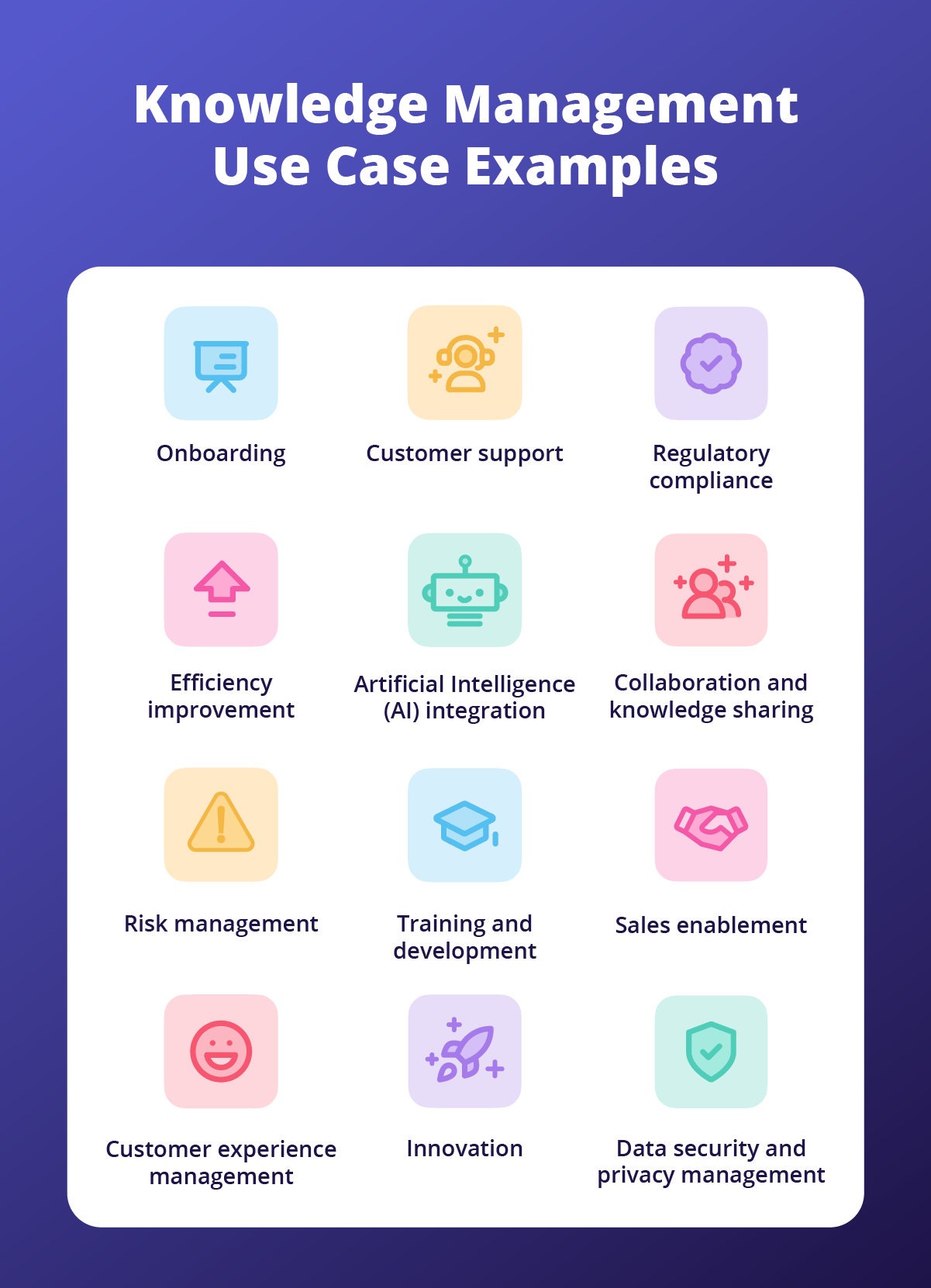12 Knowledge Management Use Case Examples for Your Organization

Key Takeaways
- Knowledge management supports key business areas including onboarding, customer support, compliance, and training by organizing and sharing critical information.
- Use cases like AI integration, collaboration, risk management, and innovation show how KM drives smarter decisions and continuous improvement.
- Implementing KM systems improves efficiency, enhances knowledge retention, and strengthens data security across the organization.
Organizations generate and handle vast amounts of information daily, yet 55% of executives report issues with information and data quality. From employee knowledge to customer data and industry research, there is an abundance of insights that, when effectively captured and managed, can significantly enhance productivity and performance. However, without a proper system to organize and distribute this knowledge, much of it remains untapped, leading to inefficiencies, miscommunication, and lost opportunities. This is where knowledge management becomes crucial.
This blog explores 12 examples of knowledge management across various business functions, showing how organizations can apply knowledge management strategies to drive performance and efficiency. Each use case example is illustrated with a specific example to highlight the practical benefits of implementing a strong knowledge management system. From enabling seamless onboarding to using AI for enhanced decision-making, these examples demonstrate the wide-ranging impact of knowledge management in modern organizations.
What is knowledge management and why does your organization need it?
Knowledge management refers to the systematic approach of creating, sharing, using, and managing the knowledge and information within an organization. It involves a blend of strategies, practices, and tools designed to identify, document, and disseminate knowledge. Knowledge management aims to ensure that valuable knowledge—whether explicit, such as documented procedures, or tacit, such as personal expertise and insights—is readily accessible to employees who need it to perform their tasks effectively.
Benefits:
- Reduces errors and inefficiencies.
- Streamlines operations and maintains quality.
- Speeds up onboarding for new employees.
- Fosters collaboration and continuous learning.
- Provides a competitive advantage in a rapidly changing business environment.
What are the knowledge management use case examples for success?
1. Onboarding
Onboarding is a critical process that introduces new employees to company culture, policies, and their specific roles. A knowledge management system can streamline onboarding by centralizing documents, training materials, and organizational information. By providing new hires with easy access to necessary resources, organizations can reduce onboarding time, improve retention, and ensure consistent training across departments. Effective knowledge management also helps preserve institutional knowledge, ensuring that key insights are available to new employees.
- Streamlines access to company culture, policies, and role-specific resources.
- Example: Tech company centralizes training videos and guides, reducing onboarding time by 50%.
2. Customer support
Customer support teams often need to quickly access a wide range of information to resolve issues efficiently. Knowledge management tools help agents find accurate answers without escalating tickets. A robust knowledge management system improves first-call resolution rates, enhances customer satisfaction, and reduces the burden on senior support staff. Additionally, self-service options powered by knowledge management allow customers to find answers to common questions without contacting support.
- Provides agents quick access to accurate answers and reduces ticket escalations.
- Example: Retail company implements a knowledge base with FAQs, cutting errors by 25% and improving satisfaction.
3. Regulatory compliance
Compliance with industry regulations is critical, particularly in heavily regulated industries like finance, healthcare, and government. Knowledge management systems can help track compliance-related documentation, training records, and regulatory updates. By centralizing compliance knowledge, organizations can ensure that employees are informed of relevant regulations and that necessary procedures are followed. Knowledge management also facilitates audits and helps mitigate compliance risks by providing easy access to up-to-date information.
- Tracks compliance documents, training records, and regulatory updates.
- Example: Bank uses a KM system to store financial regulations, aiding employee awareness and audits.
4. Efficiency improvement
Organizations seeking to improve operational efficiency can use knowledge management to eliminate redundancies, streamline workflows, and reduce wasted time. A well-implemented knowledge management system provides employees with easy access to essential information, reducing the need for duplicated efforts and minimizing time spent searching for answers. By sharing best practices and lessons learned across teams, businesses can continuously improve processes and boost productivity across departments.
- Eliminates redundancies, streamlines workflows, and shares best practices.
- Example: Manufacturing firm documents SOPs in a KM system, reducing downtime and improving
5. Artificial Intelligence (AI) integration
Knowledge management is a key enabler for artificial intelligence applications and 27% of knowledge management teams state incorporating AI is a top priority. AI systems rely on vast amounts of data to deliver insights and predictions. By organizing and structuring enterprise data, knowledge management provides the foundation for machine learning and AI tools to perform analytics and automate decision-making. Knowledge management also allows AI systems to improve over time by continuously incorporating new information and insights into their algorithms.
- Provides structured data for AI and machine learning, enhancing analytics and automation.
- Example: Healthcare provider uses AI-powered KM to analyze patient records and improve diagnostics.
6. Collaboration and knowledge sharing
Knowledge management systems enable seamless knowledge sharing across teams and departments, reducing silos and fostering collaboration. With centralized knowledge repositories, employees can share insights, documents, and best practices, leading to more informed decision-making and greater innovation. Knowledge management promotes a culture of knowledge-sharing and collaboration, which improves teamwork and helps organizations adapt to changes quickly.
- Reduces silos and promotes cross-team communication.
- Example: Global consultancy shares case studies and best practices on an internal KM platform.
7. Risk management
In industries where risk mitigation is essential, knowledge management helps capture and analyze risk-related information. By organizing data on past incidents, regulatory changes, and emerging threats, knowledge management systems equip organizations to make informed decisions and take proactive measures. This ensures that organizations are better prepared for potential disruptions and can create more robust contingency plans.
- Captures and analyzes risk data for proactive decision-making.
- Example: Insurance company documents past claims and scenarios to better assess risks.
8. Training and development
Training and development are ongoing needs in any organization, and knowledge management systems can centralize training materials, certification programs, and development resources. With a knowledge management system, employees can easily access relevant training modules, track their progress, and share insights with their colleagues. This enhances employee development by ensuring consistent access to the latest training materials and best practices.
- Centralizes training materials, certification programs, and development resources.
- Example: Pharmaceutical company provides employees access to ongoing training via KM platform.
9. Sales enablement
Sales teams often need access to a wide range of resources, including product information, customer insights, and sales scripts. Knowledge management systems streamline this by providing centralized access to the information sales teams need to close deals and build relationships. Knowledge management tools also help sales teams stay aligned with marketing and customer service, ensuring a consistent approach across departments.
- Centralizes product information, customer insights, and sales resources.
- Example: SaaS company provides sales reps with updated content, increasing deal closures by 15%.
10. Customer experience management
Improving the customer experience requires deep insights into customer preferences, behaviors, and feedback. Knowledge management systems help companies capture and organize this data, making it easier to tailor products and services to meet customer needs. By enabling a data-driven approach to customer experience management, knowledge management helps organizations provide personalized services and improve customer retention.
- Captures insights into customer behavior and feedback for personalization.
- Example: E-commerce company analyzes feedback to personalize recommendations and improve the shopping experience.
11. Innovation
Fostering innovation requires organizations to capture and share ideas, insights, and feedback from across the business. Knowledge management systems can serve as a hub for collecting employee ideas, tracking trends, and sharing research findings that drive innovation. By centralizing this knowledge, businesses can create a culture of continuous improvement and ensure that innovative ideas are developed and implemented effectively.
- Collects employee ideas, tracks trends, and shares research findings to drive new solutions.
- Example: Beverage company gathers global employee ideas, launching products based on consumer trends.
12. Data security and privacy management
Data security and privacy have become top priorities for organizations in the digital age. Knowledge management systems can help manage policies, guidelines, and best practices related to cybersecurity and data privacy, ensuring that employees are informed and compliant. A robust knowledge management approach to data security ensures that organizations can respond quickly to threats and avoid costly breaches.
- Centralizes policies and training to ensure cybersecurity and compliance.
- Example: Healthcare organization uses KM to train employees on data privacy, reducing breaches and regulatory fines.

In Summary: 12 Knowledge Management Use Cases
An effective knowledge management system enables organizations to capture, organize, and share critical knowledge across key business functions, driving better performance and innovation.
- Use cases like onboarding, customer support, and regulatory compliance benefit from centralized information that improves training, service quality, and adherence to regulations.
- Areas such as efficiency improvement, AI integration, collaboration, risk management, and training and development are strengthened by streamlined processes and shared insights.
- Sales enablement, customer experience management, innovation, and data security are enhanced by accessible knowledge that supports informed decisions and maintains compliance.
Implementing these 12 use cases increases productivity, strengthens knowledge retention, and enhances data security, helping organizations stay competitive in a knowledge-driven economy.
Implementing knowledge management examples in your organization
As these 12 use cases demonstrate, effective knowledge management can be applied across various business functions to improve collaboration, boost efficiency, ensure compliance, and more. Whether it’s onboarding new employees, enhancing customer service, or leveraging AI for data analysis, knowledge management enables organizations to maximize the value of their internal knowledge. By implementing a robust knowledge management system, businesses can unlock new opportunities, make better decisions, and stay ahead in today’s knowledge-driven economy.
To learn more about how your business can benefit from the 12 knowledge management use case examples, explore our product features.



